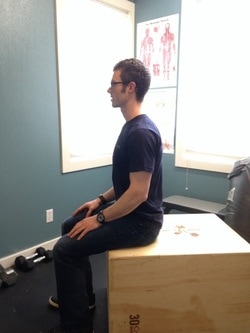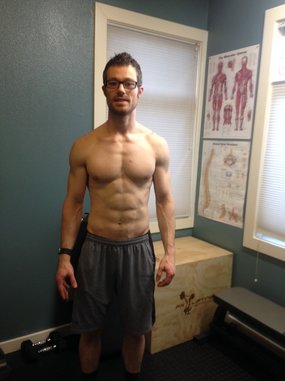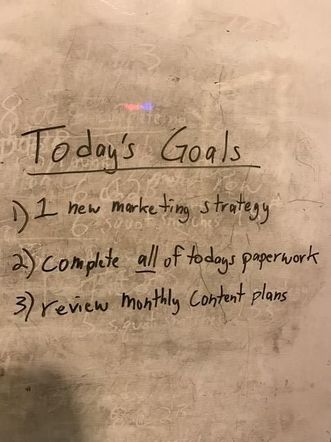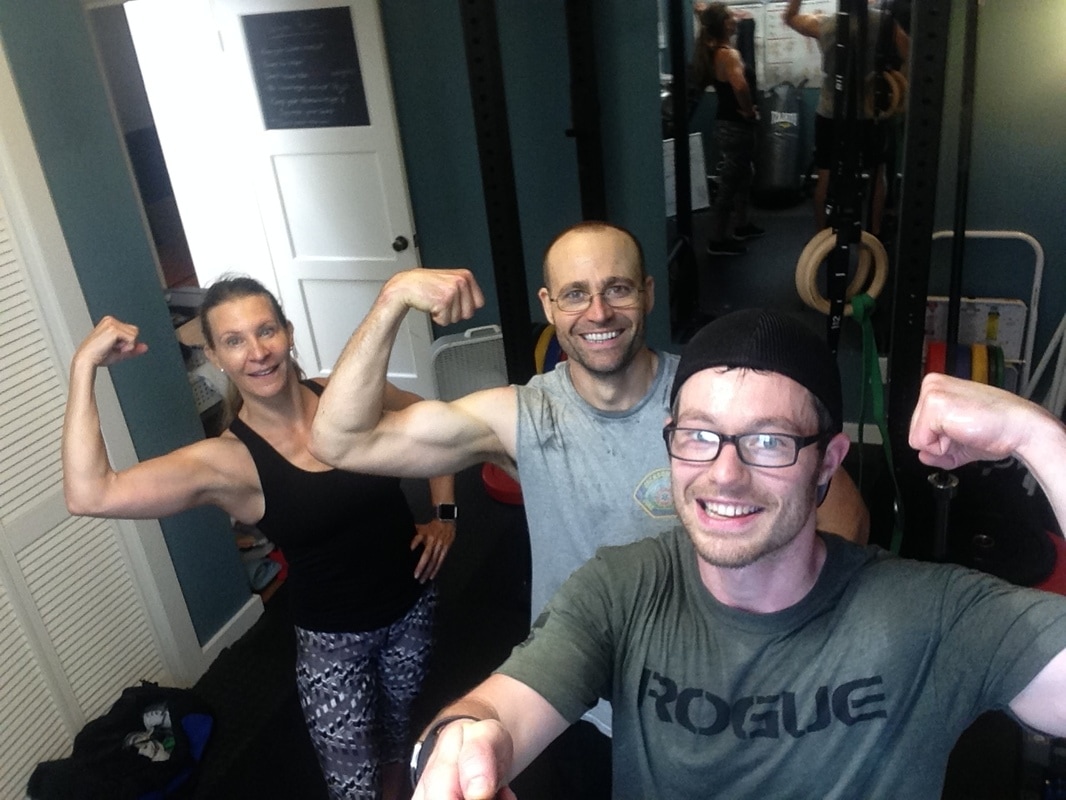|
Posture is where I would like to start. This is one of the most over-used and under-defined terms that we have in the world of health and fitness. What I mean when I say posture or more specifically good posture or ideal/proper posture is the following. When looking at you from the side, or profile view, I should see… A fairly straight imaginary line starting from your ankle bone, lined up below the middle of your knee joint, which should be just below your hip bone (greater trochanter), this line should dissect through your trunk, through the middle of your shoulder joint and directly through your ear. Looking at this from a visual aspect should look something like this…  Practicing good sitting posture Practicing good sitting posture Now, how do we get ourselves in this position, which is a practiced skill, not an automatic habit. Whether sitting or standing, we first want to create a little torque from our contact point to the floor. To do this, simply start with your feet about hip width apart, toes pointed straight in front of you. Pretend that your feet are on a piece of paper and your trying to tear that paper in half by externally rotating your feet on the floor. Take notice of the muscles that contract while performing this exercises. Now you simply engage these same muscles in your feet and your glutes and maintain a very light amount of muscle activation, about 20%, to support good posture. From this position, we now engage our core. This should also be done at a 20% contraction level while maintaining breathing. To get your shoulders, spine, shoulder blades, head and neck in a good position, there are 2 cues that I have found to be very effective with the hundreds of people I have worked with over the years. The first is from weight lifting coach Mark Bell, www.markbellpower.com, when he cues his athletes to bench press. One of his first steps is to grip the bar then pretend you are going to snap the bar in half like you were “breaking a stick”. This will create a similar external rotation torque on the bar but for posture will allow us to position our thoracic spine (rib cage area of spine), shoulder and shoulder blades in the correct position. This should then be done at about 20% muscle contraction throughout the day. The fourth and final component of this posture position that we often speak of is the head and neck position that we can realign with a move we call axial extension...
Axial extension is typically done with a combination of lightly reaching the top of your head towards the sky while also lightly tucking your chin back to restore a neutral cervical spine (neck) position. So, why all the fuss over what good posture is and how to get in this ideal position? Poor posture, which can take place in many different shapes and forms contributing to many orthopedic conditions including but not limited to the following. Shoulder impingement, bicep impingement, rotator cuff tendonitis, tendonosis, tears, spinal disorders, slipped disc, disc bulge, spondylolisthesis, retrolisthesis, headaches, muscle imbalances, poor breathing, TMJ, and others, just to name a few. Now that you know what good posture means and how to get yourself there, it’s time to start making this your new habit. Today at work you will probably spend the majority of your 8.7 hour work day* sitting at your desk pouring over work, responding to emails, and managing correspondences with co-workers. As you progress through your day and subsequently through your week, little to no thought is placed on exactly how you are sitting and the position that you are putting your body in. As the New York Times Bestselling Author Daniel Coyle puts in his book The Talent Code, “Practice doesn’t make perfect, it makes permanent.”. Therefore find ways to practice this new skill throughout your day until you can build this into your neurology and make it permanent. Keep this quote in mind when you find yourself struggling to adopt this position and remember that is has probably taken many years of “practice” to teach your body the posture you are currently in, therefore may take some time to unwind this skill. One suggestion that I have found helpful is to reset your posture (feet screwed into the floor, core engaged, break the stick, with head up and chin tucked) each time I check my watch or send/receive a text message from anyone. These built in reminders, or "habit setters" as I like to call them, can help to do just that. Make this posture one of your new healthy habits. * Disclaimer: Remember to always consult with your physician or physical therapist in regards to starting or changing your exercise routine and in no means is this information meant to diagnose or treat your injury. For full legal disclaimer, see About Me page. *average time spent per day working according to 2013 Bureau of Labor and Statistics of Americans age 25-54 www.bls.gov
1 Comment
 Understanding what your "core" muscles really are and how to use them is extremely important for your physical wellness. Understanding what your "core" muscles really are and how to use them is extremely important for your physical wellness. I have had the opportunity to work in physical therapy in the outpatient setting for over 8 years now and have learned a lot. Some of these lessons came rather quick, such as learning how to capture people’s interest to and convince them that physical therapy can be helpful and healing. Other lessons though, took much more repetitions and pattern recognition over the years to recognize. Now, looking back I can also connect many more dots and see much more clarity with people that I have worked with in the past whose cases I didn’t completely understand. Knowledge combined with repetitive experience leads to improvement. Working in outpatient physical therapy allows me the opportunity to work with all types of different people with many different injuries and stages of recovery from varying backgrounds. One of the amazing things about this work opportunity is that I get to observe common patterns, limitations, injuries, ailments, struggles, etc across many people, over a broad time frame. This has highlighted multiple patterns that are worth being aware of so that you can intervene BEFORE there are symptoms, problems or injuries. The most common injuries are… Although there are traumas and accidents that happen in life that can cause physical injury, this is a very small percentage of the people that end up in physical therapy. These situations are sometimes unavoidable, but I see this patient as the exception, Not the rule. The rule tends to be… Compensations, imbalances and underuse/overuse are mostly the cause or underlying problem when symptoms or injuries arise. I can say with confidence that if we all were to address a few of these common issues that arise from being a human in a modern day environment, than we would see a lot less of these preventable problems and have much more pain free lives. So, what are these common problems that we could address to hedge our bets against future injuries? Posture, core weakness, hip musculature imbalance and poor movement patterns, that’s it. These Four categories cover the vast majority of problems that we see in physical therapy. Almost all injuries that we treat can be funneled into one of these four categories. From your shoulder pain to your neighbors disc bulge, these are oftentimes manifestations of untreated issues that over time can lead to these painful and limiting injuries. If we are first aware of, and then begin to address ways to manage these issues, we can make a big difference in avoiding injuries. So, how do we address these four common issues? Posture: Practice good positions (ie. good posture) throughout the day by checking in with it often. Reset your posture by “breaking the stick” every time you check your phone or take a sip of coffee. And have your environment or workplace set up for ergonomic efficiency. Core Weakness: Make sure you are practicing “core setting” and working on your deep core muscles, NOT your six pack muscles, these are not the same thing. Think Kegals and spinal stabilization. Hip Musculature Imbalance: This can be a problem of muscle weakness, tightness or overall joint imbalance. Most often it is a combination of these things. To help limit or avoid this, practice moving your hips through their available range of motion daily. And take breaks from extended sitting or any stationary position. Poor Movement Patterns: This is simply being able to using your body properly and be able to navigate your environment with good mechanics over time. This can be the silent problem that you don’t realize is a problem, until you have symptoms from this going unaddressed for too long. Awareness of how you are doing things like picking up your clothes off of the floor and bending over to take out the trash make a huge difference over the long term. As I have mentioned in a previous blog post, it is of the upmost importance that we all have a regular movement practice. The great part about this, is that it can take care of all of the above mentioned problems, if structured in the correct way. Read more about this here... * Disclaimer: Remember to always consult with your physician or physical therapist in regards to starting or changing your exercise routine and in no means is this information meant to diagnose or treat your injury. For full legal disclaimer, see About Me page.
 Little Jiro giving some good eye contact with those alien eyes! Little Jiro giving some good eye contact with those alien eyes! Many of us find ourselves working in environments that involve increasing interactions with others, despite the increased technology and opportunities to be more unique in the workplace and elsewhere. The more that we progress with this tech and ever shifting work environments, it is going to be even more important that we are effective with our communication. This is important for many reasons including; portraying your thoughts and ideas accurately, making sure your questions or concerns are heard and to improve collaboration with others while working towards a common goal. Without effective communication, all things become more difficult. We have all had those times, wether at work, school, or at home, when we were given a task but with little to no clarity on what we are actually trying to accomplish. At best, this will waste time as you try and figure it out on your own. But, what more often seems to happen is that this leads to confusion, frustration and much less accomplishment than if there was a clearly defined goal. If we start with good communication in mind, these setbacks can be mitigated if not avoided altogether. Here are 5 specific principles that I have found to be helpful.
3. Goals: Speak with clear goals in mind and review these goals often. This can also ensure that all parties are on the same page of what the focus is, and can help to accomplish more. 4. Check-in: Check in with your patient (friend or coworker), constantly to clear up any potential confusion or lack of understanding. This will make your life easier by reducing the chances of misunderstandings and give them a better experience. 5. Bring the details: Make sure to educate your colleague on exactly it is that you are working on and your proposed solution, including the details. But, make sure to come back to the big picture and relate this back to your overall goal with analogies or simplified comparisons to promote clarity and understanding. Clear up confusion.  Writing your goals down can help to make them a reality. Writing your goals down can help to make them a reality. Although these principles are written specifically for the context of outpatient physical therapy and personal training, these could be used and applied to most all situations or relationships where there is a common goal or plan to accomplish, and when simply working with others. All of these seem so simple, and they can be. It is oftentimes not the complicated things that are needed, but rather the simple things repeated over time.  My Morning Alarms My Morning Alarms “Success Is the Progressive Realization of a Worthy Ideal” -Earl Nightingale When you start to look around, it is interesting to see all of the different types of people that are out in the world. I think this is such an amazing thing about people, the fact that we can be so different, yet deep down share so many of the same attributes, goals, problems and ambitions. With all of the access into people’s lives’ through online platforms and social media, especially those of the rich and famous, it can feel discouraging or at least intimidating when seeing how much accomplishment people are able attain in their life. Some people seem to have more hours in the day than the rest of us based on how much they are able to get done in a day. I know that I have struggled to get through my work day with spare time to do some laundry, make dinner, and try to squeeze in a little reading before going to bed and repeating this same sequence the next day. For me, this was the routine for my first year working as a full time Physical Therapist Assistant at an outpatient physical therapy clinic. I would wake up about an hour before going to work. I would give myself enough time to rush through a shower, possibly some breakfast or more likely MY COFFEE, then rush to work. When I came home, I would try to fit in a workout, make dinner, then, there I would find myself at the end of my day. After feeling more and more anxious about not making progress towards my personal goals outside of work, I decided to run a little thought experiment. What if I woke up HOURS before I needed to be at work and started working on my personal goals first? Could this allow me to get more done in my day? Or, at least make sure that I don’t neglect the important things such as my daily movement practice and morning journaling. I thought this may also be a good way to establish a consistent Morning Routine that could take pressure off of me the rest of the day to be productive. I decided to give this a shot and committed to myself that I would try 30 days of getting up at 5am during the week. I needed to be at work at either 9am or 10am, depending on the day and would therefore have multiple hours each morning to work on my personal goals. I would also force myself to stick to a bedtime of 9pm to allow for a full 8 hours of sleep. Because I am inherently lazy, (which is what my previous schedule had taught me), I figure, if I could stick to this schedule, it wouldn’t allow for my laziness to get in the way. Or in other words, If I Designed a better schedule, I wouldn’t have to rely on my Discipline. I’m not having to be discipline with limiting my sleep or burning the candle at both ends. Instead, I am just shifting my sleep time to start a little earlier and end a little earlier which allows me to have time when no one else is around, to take care of my own goals. I waste less evening time and therefore have more morning time to create opportunities. At first, as in with any other change, getting up this early was uncomfortable. But, change is always uncomfortable, and once I was able to get through this stage of a few weeks, I began to almost immediately start to see the fruits of my labor. I am now over a year in, and continue to see the benefits of putting in the time for myself daily, before going to work and doing what I am paid for. It is too easy to get caught in complacency with life if you are not constantly working on getting better and improving yourself daily. I am much more consistent with my daily movement practice and exercise. I have been able to read and consume audiobooks at about 3-4x the rate as before, I also seem to have much less stress the rest of my day at work. I believe this is due to the fact that by the time I get home from work, all I really have to do is eat dinner and relax before going to sleep. Knowing that I have already accomplished so many of my goals for the day, allows me to be better at focusing on the task at hand and not thinking about other projects or commitments, as these are already taken care of. Remember, it is important to know yourself and consider your personal strengths and weaknesses so that you can design around these to optimize the life that you want. Because I personally have a combination of the desire to accomplish and learn constantly but have daily lazy tendencies, I am constantly working on ways to design my time around my faults to create the ideal life for me that I desire. Life is a game of constant trial and error, adjust and pivot, and guess and checks. As each day provides new opportunities to learn and grow, I just do my best and try to get better with every attempt. And just as Earl Nightingale so cleverly points out that since “Success is the Progressive Realization of a Worthy Ideal”, as long as we are working towards our goal, we are successful. Success Equals Progress We were built to move. From how our anatomy is designed to how our brain learns and develops, all of your functioning improves with movement. And, exactly the opposite is true with the lack of movement or being sedentary. I know from my many years of experience working in physical therapy and from seeing friends and family as well as my own personal experiences, this very simple truth. When we stop using our body, we begin to lose the ability to use our body. Or, put more simply, Use It Or Lose It. This is demonstrated through many systems and physiological processes in our body. For example, muscle tissue and strength. When we stop exercising, or more severely are laid up in bed or in a hospital, we see almost immediate muscle atrophy and loss of strength. This same process happens with muscle extensibility or flexibility. If you stop reaching overhead and don’t use your shoulder joint, you will get stiff muscles at best and could develop muscle contractures or joint capsule adhesions at worst and lose the ability to reaching overhead. This similar process happens in our neurological system as well. Whenever we do a task, including how we hold our body (posture), and how we walk, our brain sends signals down nerve pathways that communicate how and when certain muscles should move and how far etc. Each time this happens, our body myelinates this specific neurological pathway and we become physiologically more efficient at this task. “Myelin is a fatty white substance that surrounds the axon of some nerve cells, forming an electrically insulating layer. It is essential for the proper functioning of the nervous system.The production of the myelin sheath is called myelination or myelinogenesis.” -wikipedia This happens constantly with everything we do, weather this is something we want to be good at or not. This is why so many people end up having very poor posture and many orthopedic problems from this later on in life. You don’t tend to notice these changes as they happen very slow and consistent over time. But as the other Daniel Coyle writes in his fantastic book The Talent Code, “Practice doesn’t make perfect, it makes permanent”. So, if we want to live a long and healthy life without pain as we age, I believe that hedging our bets by adapting a daily movement practice as one of the best time investments you can make.  Practicing Good Posture Practicing Good Posture What Is A Movement Practice? If we can practice good positions and movement, in a controlled environment, on a regular basis, it can go a long way in helping to mitigate against future ailments of aging as well as overuse and seemingly random injuries. Now, since everybody's body is different and what we do throughout our days and work, can be much different from each other. And, because of how our body adapts to repetitive movements and positions, a tailored approach is needed. I believe that a good movement practice should be specific to you and your body and should bridge the gap between what you do for work and full human physical capability. Now, I think a few definitions are in order since I am talking about a very specific approach when I this of the ideal movement practice. Good Positions and Movements For this purpose, I am talking about practicing good posture, a neutral spine and controlled movement in and out of those optimal positions. A good example of this could be a squat, where I am controlling my neutral spine position (posture) while moving my body up and down through space so that when I have to get off of the toilet or out of the car, my body is well practice and rehearsed on how to do this properly, therefore the task becomes easier for me and I have a reduced chance of injury because of this adaptation. Another example could be a weighted curl to press exercises where you are now taking a weight from your side to up overhead, then return it to your side. This is a great way to build stability in your shoulder joint as well as your spine while practicing taking this shoulder joint through its range of motion with control to again build the ability to repeat this next time you have to take that heaving box down from the top shelf in your closet or garage. Controlled Environment The controlled environment could actually be many different things or places. When beginning an exercise or routine, this could simply be your living room where you practice some bodyweight squats. If you enjoy working out with others, this could mean your local health club or crossfit gym. The important distinction is that it is a place that you can safely focus on improving your skill in whichever position or movement you are working on and also does Not include all of the environmental factors that would be present when executing this task in a real life scenario. So, using the previously discussed squat example for getting off of the toilet. Let's say this exercise routine is for your grandmother who is in her 80’s and is losing strength and is finding it harder and harder to get herself off of the toilet at home. A great exercise in a controlled environment for her could be in her kitchen, standing in front of the sink with a chair sitting behind her. She could wrap her hands over the edge of the sink for support with her arms and then sick back towards the chair, stopping just short of sitting, and then returning back to her starting standing position to practice this squat in a safe controlled manner. (Remember, this is not an exercise prescription and always consult your physician or physical therapist before starting or changing your exercise routine, don’t hurt grandma!) Regular Basis How many times per day or days per week someone should exercises or work on their movement practice can range vastly depending on many factors. I’ve seen and personally done exercise routines that are 2x per week, 4x per week and even 7x per week. The routines themselves differed and the condition I was in was different for each of these times periods also. Some factors to consider when looking at exercise frequency include; exercise experience, current health status, physical goals, age, gender, past or current injuries, nutrition, sleep, schedule, equipment access, exercise type, etc. As you can see, navigating the specifics and nuances of all these factors can be a daunting task and I believe that they are in constant flux or change. So, this is where the expertise of a coach, personal trainer, physical therapist, or other specialist can be very helpful in helping to navigate some good starting points and programs or approaches that might help you find what your body needs specifically. One point that may be where considering also is that oftentimes less is more especially when it comes to making physiological changes and even more so in regards to strength gain and muscle hypertrophy. But for other goals, such as improving our posture which is very much dominated by the constant repetitions with our neurological system tend to improve better with many many almost constant repetitions or practice. Therefore consult a professional, start slow, especially with things that are new and/or heavy and be consistent. |
Author : Jordan ProudfootHere are my thoughts and insights into fitness and wellness to be the best you possible. Archives
February 2019
Categories
All
|






 RSS Feed
RSS Feed
